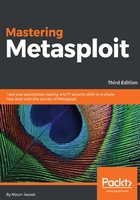
What this book covers
Chapter 1, Approaching a Penetration Test Using Metasploit, takes us through the absolute basics of conducting a penetration test with Metasploit. It helps establish an approach and set up an environment for testing. Moreover, it takes us through the various stages of a penetration test systematically. It further discusses the advantages of using Metasploit over traditional and manual testing.
Chapter 2, Reinventing Metasploit, covers the absolute basics of Ruby programming essentials that are required for module building. This chapter further covers how to dig existing Metasploit modules and write our custom scanner, authentication tester, post-exploitation, and credential harvester modules; finally, it sums up by throwing light on developing custom modules in RailGun.
Chapter 3, The Exploit Formulation Process, discusses how to build exploits by covering the essentials of exploit writing. This chapter also introduces fuzzing and throws light on debuggers too. It then focuses on gathering essentials for exploitation by analyzing the application's behavior under a debugger. It finally shows the exploit-writing process in Metasploit based on the information collected and discusses bypasses for protection mechanisms such as SEH and DEP.
Chapter 4, Porting Exploits, helps to convert publicly available exploits into the Metasploit framework. This chapter focuses on gathering essentials from the available exploits written in Perl/Python, PHP, and server-based exploits by interpreting the essential information to a Metasploit-compatible module using Metasploit libraries and functions.
Chapter 5, Testing Services with Metasploit, carries our discussion on performing a penetration test over various services. This chapter covers some crucial modules in Metasploit that helps in testing SCADA, database, and VOIP services.
Chapter 6, Virtual Test Grounds and Staging, is a brief discussion on carrying out a complete penetration test using Metasploit. This chapter focuses on additional tools that can work along with Metasploit to conduct a comprehensive penetration test. The chapter advances by discussing popular tools such as Nmap, Nessus, and OpenVAS, and explains about using these tools within Metasploit itself. It finally discusses how to generate manual and automated reports.
Chapter 7, Client-Side Exploitation, shifts our focus on to client-side exploits. This chapter focuses on modifying the traditional client-side exploits into a much more sophisticated and certain approach. The chapter starts with a browser-based and file-format-based exploits and discusses compromising the users of a web server. It also explains how to modify browser exploits into a lethal weapon using Metasploit along with vectors such as DNS Poisoning. At the end, the chapter focuses on developing strategies to exploit Android using Kali NetHunter.
Chapter 8, Metasploit Extended, talks about basic and advanced post-exploitation features of Metasploit. The chapter advances by discussing necessary post-exploitation features available on the Meterpreter payload and moves on to discussing the advanced and hardcore post-exploitation modules. This chapter not only helps with quick know-how about speeding up the penetration testing process but also uncovers many features of Metasploit that save a reasonable amount of time while scripting exploits. At the end, the chapter also discusses automating the post-exploitation process.
Chapter 9, Evasion with Metasploit, discusses how Metasploit can evade advanced protection mechanisms such as an antivirus solution using custom codes with Metasploit payloads. It also outlines how signatures of IDPS solutions such as Snort can be bypassed and how we can circumvent blocked ports on a windows-based target.
Chapter 10, Metasploit for Secret Agents, talks about how law enforcement agencies can make use of Metasploit for their operations. The chapter discusses proxying sessions, unique APT methods for persistence, sweeping files from the target systems, code caving techniques for evasion, using venom framework to generate undetectable payloads, and how not to leave traces on the target systems using anti-forensic modules.
Chapter 11, Visualizing with Armitage, is dedicated to the most popular GUI associated with Metasploit, that is, Armitage. This chapter explains how to scan a target with Armitage and then exploit the target. The chapter also teaches the fundamentals of red-teaming with Armitage. Further, it discusses Cortana, which is used to script automated attacks in Armitage that aid penetration testing by developing virtual bots. At the end, this chapter discusses adding custom functionalities and building up custom interfaces and menus in Armitage.
Chapter 12, Tips and Tricks, teaches you various skills that speed up your testing and help you to use Metasploit more efficiently.